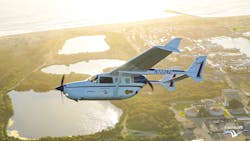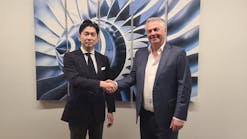“Hybrid Electric Retrofits Will Lead the Way in Decarbonizing Aviation”
Los Angeles, CA. July 17, 2019 In remarks ahead of the EAA AirVenture airshow this month, Ampaire CEO Kevin Noertker revealed the company’s roadmap toward new all-electric commuter aircraft, beginning with the rapid introduction of electric powertrains on currently certified aircraft. This approach addresses two major problems in commercial aviation today—high operating costs and the environmental impact of CO2 and other emissions.
Ampaire has begun a flight test program on its first commercial product, the Ampaire Electric EEL, a twin-engine Cessna 337 Skymaster modified to fly with one conventional combustion engine and one electric motor. It is the largest hybrid-electric aircraft flying today. The Electric EEL will enter flight trials on commercial routes with Mokulele Airlines in Hawaii later this year, a partnership enabled by a Hawaii-based startup accelerator, Elemental Excelerator. FAA certification of the Electric EEL is projected for 2021.
“The most practical way to achieve an all-electric future is to jump start the market with a partially-electric present,” said Noertker. “We’re pursuing a pragmatic, step-by-step approach, a scalable plan to quickly commercialize and expand the electric airplane market. This approach recognizes that other development programs for clean-sheet all-electric aircraft will consume hundreds of millions of dollars in R&D and potentially require a decade or more to certify.
“Such programs will be complicated by the rapid evolution and improvement of electric battery and powertrain technology, and the lack of experience of regulators in the area of electric aircraft.
“In contrast, Ampaire is currently demonstrating the ability to cut fuel consumption by 50 percent and reduce emissions accordingly. The development cost of modifying an existing aircraft is relatively low and manageable versus a clean-sheet design. Both Ampaire and the FAA have an opportunity to work together to develop a regulatory framework that promotes safety and creates a predictable, manageable path for certifying electric aircraft.
“The Cessna 337 modification is a first step. The next may be a hybrid or fully electric retrofit of a nine- to 19-passenger commuter/cargo aircraft. As batteries and powertrains mature, we will shift our focus to clean-sheet designs such as our nine-passenger, zero-emissions Tailwind concept.
“By that time, we will have established strong cash-flow from retrofit programs as well as engineering and certification expertise that will earn the confidence of investors, partners, aircraft operators, and regulators.”
Noertker pointed to UBS’s recent estimate of a $200 billion market for hybrid electric aircraft. He will be meeting with the public and the media at Oshkosh booth D-10 in the EAA Urban Air Mobility Showcase and will discuss the emerging electric aviation market at 10 am July 24th at AirVenture’s Aviation Gateway Park and during other speaking opportunities at the show.




